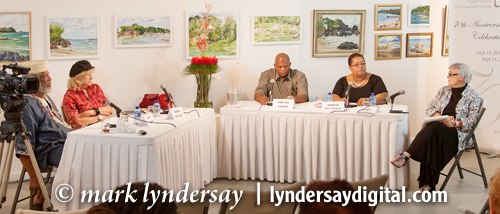Art Society: Elder Conversation 3
29/07/13 23:45 Filed in: Reviews
Hard talk
The Art Society’s Conversation with the Elders 3, originally published in the Guardian's Sunday Arts Magazine for July 28, 2013

Panelists at the Conversation with the Elders 3 event at the Art Society’s headquarters were, from left, Leroy Clarke, Sarah Beckett, Trevor Byron, Marcia Des Vignes and moderator Diana Mahabir Wyatt.
Photograph by Mark Lyndersay.
At each of the Art Society’s panel discussion series, there’s been one speaker who has commanded the conversations. At the first talk, it was Willi Chen, whose outspoken candor challenged and engaged the audience. At the second, unsurprisingly, it would prove to be Peter Minshall, whose passion for local art and concerns about its development drove his eloquent discourse on the subject.
At the third edition of the event on July 18, Leroy Clarke emerged as the man commanding the microphones.
Clarke isn’t always loquacious when given an opportunity. Sometimes he can subside into a sullen torpor, bound by restraints only he can perceive.
At this event though, the veteran artist, after a tentative, even cautious start, let loose with his signature vigour on an audience that must have expected something strong from him, but perhaps not a statement quite as blunt as “I don’t like the Art Society.”
But that’s racing ahead to the juicy parts, and Leroy Clarke wasn’t the only panelist at the event.
Under the rubric “The visual arts in Trinidad and Tobago in the last quarter of the twentieth century” four panelists explored the state of art between 1975 and the turn of the century. Moderated by Diana Mahabir Wyatt, Marcia Des Vignes, designer and arts educator, Trevor Byron, marine artist and arts educator, Sarah Beckett, artist and poet and Leroy Clarke, artist and poet offered their thoughts on the subject at hand.
Well, sort of. The history of art in the last 25 years of the 20th Century were, apparently as grim and unadventurous as one might imagine from the collective output of the era.
For the arts educators, it was uphill all the way.
“The THA made a difference in providing a space for art and artists,” Marcia De Vignes and educator in the school system for the last 33 years said, “but parents and teachers actively dissuade children from pursuing art as a career.”
“South,” noted Trevor Byron, “had it harder than Tobago.”
After listing the impressive roster of artists from the south of the country who have become national and international names, Byron, an art teacher for 31 years, lamented the steady migration of talented artists to the north of the country.
Sarah Beckett, who acknowledged that she came to the country in 1969 for love, began her work as an artist here when there were no galleries, held her first showing of work at part of the group of six at Bishop Anstey High School.
“What’s important is the development of art in the country,” Beckett said.
“Rambissoon, Bishop and Chu Foon all had a vision of art coming from this small country and finding a place in the world.”
Leroy Clarke’s vision was a bit more bleak.
“I was born a dissatisfied man,” he told the Art Society audience.
“Unsatisfied, not pleased with anything. So I set about doing something. Trinidad is a brutal place, and if we haven’t made a mark in the world in 50 years, it’s because of that.”
On his return from working and studying abroad, Clarke returned to Trinidad and Tobago with, as he puts it, murder on his mind.
“I returned to kill two people,” he said.
But the two, Boscoe Holder and Carlisle Chang, apparently preferred to sit and have a drink with the angry young artist, sharing their lives and work with him. Clarke would eventually deviate from his lethal intent, sure that both men were dead already, apparently slaughtered by the challenges of working in the country.
“I had the blessing of Carlisle Chang,” Leroy Clarke said in a moment of acknowledgement and genuine appreciation.
It was a rare gracenote from the panel, who seemed with precious few such exceptions, to have little that was positive to report from the frontlines of art during the last quarter of the 20th century.
The next panel, scheduled for September 04, will engaged the young turks of the art world who have emerged since then in a discussion and contemplation of where art is going in its next generation.
The Art Society’s Conversation with the Elders 3, originally published in the Guardian's Sunday Arts Magazine for July 28, 2013

Panelists at the Conversation with the Elders 3 event at the Art Society’s headquarters were, from left, Leroy Clarke, Sarah Beckett, Trevor Byron, Marcia Des Vignes and moderator Diana Mahabir Wyatt.
Photograph by Mark Lyndersay.
At each of the Art Society’s panel discussion series, there’s been one speaker who has commanded the conversations. At the first talk, it was Willi Chen, whose outspoken candor challenged and engaged the audience. At the second, unsurprisingly, it would prove to be Peter Minshall, whose passion for local art and concerns about its development drove his eloquent discourse on the subject.
At the third edition of the event on July 18, Leroy Clarke emerged as the man commanding the microphones.
Clarke isn’t always loquacious when given an opportunity. Sometimes he can subside into a sullen torpor, bound by restraints only he can perceive.
At this event though, the veteran artist, after a tentative, even cautious start, let loose with his signature vigour on an audience that must have expected something strong from him, but perhaps not a statement quite as blunt as “I don’t like the Art Society.”
But that’s racing ahead to the juicy parts, and Leroy Clarke wasn’t the only panelist at the event.
Under the rubric “The visual arts in Trinidad and Tobago in the last quarter of the twentieth century” four panelists explored the state of art between 1975 and the turn of the century. Moderated by Diana Mahabir Wyatt, Marcia Des Vignes, designer and arts educator, Trevor Byron, marine artist and arts educator, Sarah Beckett, artist and poet and Leroy Clarke, artist and poet offered their thoughts on the subject at hand.
Well, sort of. The history of art in the last 25 years of the 20th Century were, apparently as grim and unadventurous as one might imagine from the collective output of the era.
For the arts educators, it was uphill all the way.
“The THA made a difference in providing a space for art and artists,” Marcia De Vignes and educator in the school system for the last 33 years said, “but parents and teachers actively dissuade children from pursuing art as a career.”
“South,” noted Trevor Byron, “had it harder than Tobago.”
After listing the impressive roster of artists from the south of the country who have become national and international names, Byron, an art teacher for 31 years, lamented the steady migration of talented artists to the north of the country.
Sarah Beckett, who acknowledged that she came to the country in 1969 for love, began her work as an artist here when there were no galleries, held her first showing of work at part of the group of six at Bishop Anstey High School.
“What’s important is the development of art in the country,” Beckett said.
“Rambissoon, Bishop and Chu Foon all had a vision of art coming from this small country and finding a place in the world.”
Leroy Clarke’s vision was a bit more bleak.
“I was born a dissatisfied man,” he told the Art Society audience.
“Unsatisfied, not pleased with anything. So I set about doing something. Trinidad is a brutal place, and if we haven’t made a mark in the world in 50 years, it’s because of that.”
On his return from working and studying abroad, Clarke returned to Trinidad and Tobago with, as he puts it, murder on his mind.
“I returned to kill two people,” he said.
But the two, Boscoe Holder and Carlisle Chang, apparently preferred to sit and have a drink with the angry young artist, sharing their lives and work with him. Clarke would eventually deviate from his lethal intent, sure that both men were dead already, apparently slaughtered by the challenges of working in the country.
“I had the blessing of Carlisle Chang,” Leroy Clarke said in a moment of acknowledgement and genuine appreciation.
It was a rare gracenote from the panel, who seemed with precious few such exceptions, to have little that was positive to report from the frontlines of art during the last quarter of the 20th century.
The next panel, scheduled for September 04, will engaged the young turks of the art world who have emerged since then in a discussion and contemplation of where art is going in its next generation.
blog comments powered by Disqus
